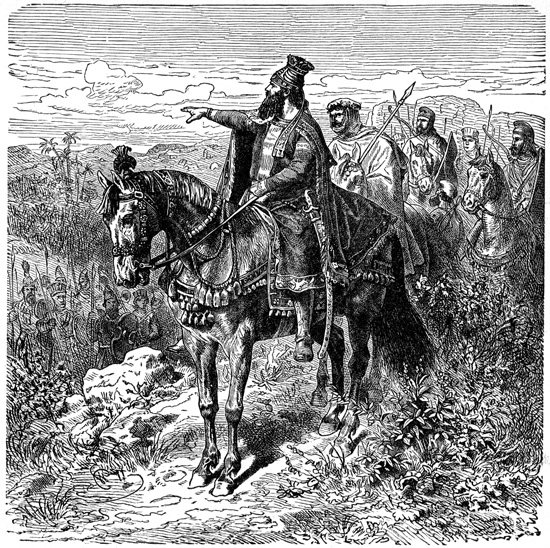 |
| Cyrus II |
Cyrus II, also called Cyrus the Great, was the founder of the Persian Empire (539–331 b.c.e.). Born in about 600 b.c.e. Cyrus II was son of Cambyses I, grandson of Cyrus I, and great-grandson of Achaemenes, from whom the rulers of the Persian Empire take the name Achaemenids, or Achaemeneans.
At the time of Cyrus’s accession in 559 b.c.e., Persia was only a small tribal state in a world ruled by the then-dominant powers of Media, Lydia, Chaldea, and Egypt. Of these the Medes were, like the Persians, of Iranian blood and language lineage and had entered the high Iranian plateau some 1,000 or more years earlier.
In the first half of the sixth century b.c.e. the Persian tribes were vassals of the Medes, and Cyrus was the son from the marriage of his Persian father with the daughter of the Median king, Astyages. When Cyrus ascended the throne, his grandfather Astyages was still king of Media.
  |
In 550 b.c.e. Astyages, concerned that his grandson was plotting with his enemy Nabonidus of Babylon, summoned Cyrus to his capital, Ecbatana, for an explanation. Cyrus refused to come, and this led to war between Media and Persia that ended with victory for the Persians and Cyrus’s becoming king of both the Medes and the Persians.
With Media conquered, Cyrus began a 10-year campaign that would create the greatest empire the world had known. He first tackled Croesus, the fabulously wealthy king of Lydia, and in 547 b.c.e. defeated him at the Battle of Ptyerum.
With Lydia conquered, he quickly defeated the Greek city-states of Ionia, and the whole of Asia Minor came under his rule. He now turned his view east and conquered Parthia and Aria in eastern Iran, the Sogdians and Bactria in Turkistan and Afghanistan, and even the western edges of India.
The Persian Empire stretched 3,000 miles from east to west but did not yet include the culturally and materially rich areas of Babylonia and Egypt. Egypt was left for his son to conquer, but Babylon was ready for a new ruler, and already those who wanted to see Persian rule in Babylon were growing in numbers.
In part this was due to dissatisfaction with the kings who presided at the time, Nabonidus, who had been absent from Babylon for 10 years, and his regent son Belshazzar, referred to in the book of Daniel in the Bible.
Equally important was the enlightened way in which Cyrus treated the states he conquered. Unlike the conquering Babylonian kings, and before them the Assyrian kings, Cyrus went out of his way to win the goodwill of his new subjects rather than to frighten them into obedience.
He presented himself as a liberator, treating prisoners with mercy, leaving local customs intact, and encouraging established religions. Cyrus attacked Babylonia in the autumn of 539 b.c.e. Belshazzar deployed his troops along the Tigris but was numerically overwhelmed even before Gubaru, the governor of the Babylonian province of Gutium, defected to the Persians.
After a campaign that lasted less than a month, Cyrus entered Babylon on October 12 without battle. From that day onward he treated the inhabitants with utmost respect, ensuring that society quickly went back to normal life and that the gods that had been taken into the city for safekeeping during the conquest were returned to their shrines in the cities of Babylonia.
Cyrus recorded his conquests and the way he treated the people of defeated cities in cuneiform script on clay or stone cylinders. These could be rolled over wet clay to create imprints, which when dried were sent out as letters or decrees. One such cylinder, today kept in the British Museum in London, gives us a glimpse into Cyrus’s empire.
It reads: “I am Cyrus, king of the world, great king, legitimate king, king of Babylon, king of Sumer and Akkad, king of the four rims of the earth, son of Cambyses, great king, king of Anšan, grandson of Cyrus, great king, king of Anšan, descendant of Teispes, great king, king of Anšan, of a family which always exercised kingship, whose rule Bêl and Nabû (the gods) love, whom they want as king to please their hearts.”
Later, on the same cylinder, Cyrus proclaims the freedom he is offering to captives. Some of those captives are the Jews who had been taken captive by the Babylonians in 587 b.c.e. and earlier in 597 b.c.e. by Nebuchadnezzar II.
In the biblical book of Ezra we read that in Cyrus’s first year of rule in Babylon he proclaimed to the Jews that they were to “go and build a house for God in Jerusalem,” and to facilitate this he returned to them the gold and silver that Nebuchadnezzar had taken from the Jerusalem temple.
After his successful conquest Cyrus remained in Babylon about a year and then moved back to the high plateau city of Ecbatana, the ancient capital of Media. However, we have almost no record of Cyrus’s actions between then and his death. In 530 b.c.e. Cyrus left his son Cambyses as regent in Babylon and personally set off to deal with a problem on his far northeastern border.
The campaign started well, but Cyrus was lured deep into the enemy territory and was there fatally wounded. His body was recovered by Cambyses II, and placed in a tomb at the Persian capital, Pasargadae, 50 miles north of Shiraz in modern-day Iran, where it can still be seen today.